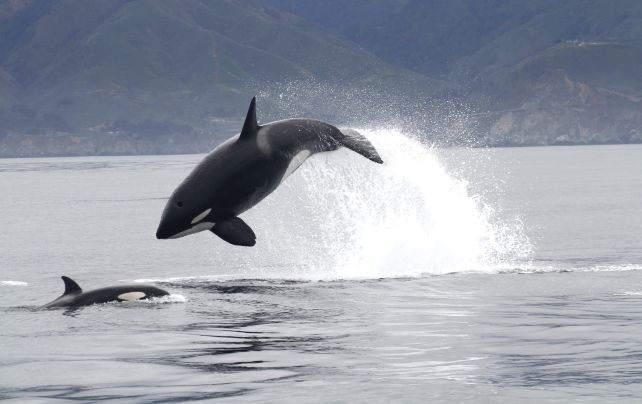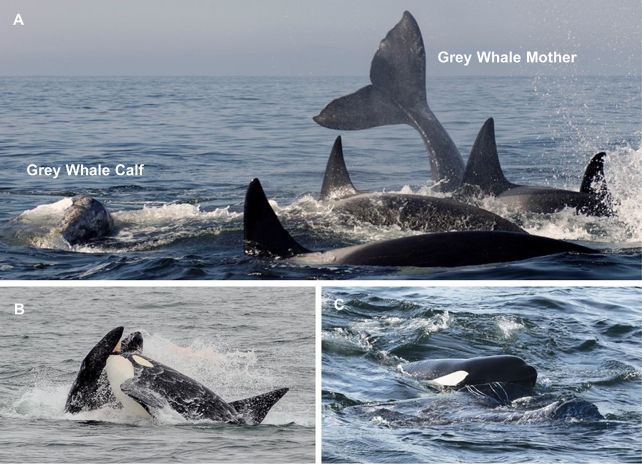ARTICLE AD
A population of orcas hanging out far off the coast of California have worked out the best methods for hunting their prey in open waters.
With a diet consisting almost entirely of marine mammals, orcas need to maximize their hunting success to make sure that everyone gets fed.
Closer to the coast where the species on which the orcas feed can be easily cornered and caught, competition can be fierce. Heading further out to sea can provide more food for those who know how to catch it.
The orcas making up the transient population of the Northeast Pacific have figured out that seals and baby whales can be caught with a mix of cunning and brute force. They ram their prey, or slap it into the air with their tails, before settling in for the feast.
"The subpopulation of transient killer whales we observed in Monterey Bay preferentially stayed in open, deep water, and primarily fed on seasonally available California sea lions, gray whale calves, and northern elephant seals," write a team led by marine biologist Josh McInnes of the University of British Columbia in Canada.
"They exhibited specialized hunting techniques that differ from those used to capture marine mammals in shallow near-shore waters associated with reefs, rocky outcroppings, and islets."
 Orca in the throes of body slamming an unseen seal off the coast of California. (Josh McInnes)
Orca in the throes of body slamming an unseen seal off the coast of California. (Josh McInnes)Across the world, orcas fall into subgroups that are genetically and culturally distinct from one another, known as ecotypes. Three ecotypes can be found in the Northeast Pacific Ocean – resident, transient, and offshore populations.
These groups have their own ways of living the orca life; although they can be seen in the same general vicinity, they are genetically distinct, have different physical characteristics, pursue different prey types, and do not interact or interbreed with each other. They even have their own orca languages.
The transient orcas specialize in marine mammals – seals, and other cetaceans, such as dolphins and whales. Because humans live on land, we're able to see how the transient orcas go about their hunting along coastlines pretty easily, and their techniques are fairly well documented.
In the late 1980s, scientists noticed offshore Canada that some members of the transient population could be found further asea where the inner coastal hunting techniques wouldn't necessarily work. They wanted to know how these outer coastal transients go about securing a meal.
Their work consisted of conducting an analysis of all the information that they could get their hands on – marine mammal surveys between 2006 and 2018, and whale watching tours between 2014 and 2021 – compiled into a long-term database of orca encounters.
Between 2006 and 2021, encounters with the outer coastal transient orca population were documented. Their behaviors and group sizes all varied seasonally, with the greatest overall encounters documented in spring, when the gray whales migrate north from their calving lagoons around the coast of Mexico.
They were seen in the open waters hunting sea lions, northern elephant seals, dolphins and porpoises, and the calves of gray whales.
 A sequence of images showing the orcas hunting the calf of a gray whale. (McInnes et al., PLOS One, 2024)
A sequence of images showing the orcas hunting the calf of a gray whale. (McInnes et al., PLOS One, 2024)To hunt the sea lions, multiple orcas surrounded a prey animal, taking turns rushing in and ramming it or hitting it with their head or tail. They would also toss the sea lion into the air. Once the sea lion was dead, the group would divide and eat the animal, or carry it around for a while. For elephant seals, the technique varied a little, with the orcas surrounding the animal, hitting it with their tails, then grabbing it by the fins to shake it.
Hunts of gray whale calves were often initiated and led by adult female orcas. The group would chase the mother gray whale and calf until the calf started to tire. Then, the orcas worked to separate the calf, coming between it and the mother and grabbing on to the calf to drag it away. The hunt would get pretty brutal, with the orcas ramming and biting the calf, and leaping on top of its blowhole to drown it.
For dolphins, the hunts were highly coordinated, with the orcas flanking a large school of dolphins to separate out individuals. Once a dolphin was vulnerable, the orcas would ram it from underneath to fling it into the air, or grab it and drag it under the water, until it was dead. Similar techniques were used to hunt porpoises.
These findings, the researchers say, help us better understand the complexities of the North Pacific ecosystem, and how orcas fit into the various food webs. It also gives us context for interpreting populations and behaviors of the orca prey species that can be found therein.
"Transient killer whales have been studied primarily in coastal shallow water habitats, and there is currently little known regarding their behavior in offshore and deep pelagic systems," they say.
"This study highlights the complex foraging behavior and ecology of transients and how they act as apex predators in productive deep submarine canyon systems and how their behavior is linked to multiple marine mammal prey populations in the North Pacific Ocean."
The research has been published in PLOS ONE.

 9 months ago
57
9 months ago
57 

